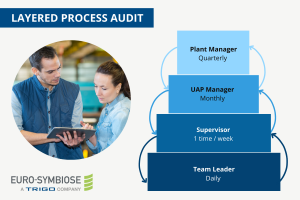🇬🇧 LPA (Layered Process Audit)

Put on the “EURO-SYMBIOSE glasses” to better understand the method !
Written by : Christophe Girard, EURO-SYMBIOSE Consultant & Trainer
LPA audit – Layered Process Audit – is a tool for checking standard rules application and a routine for managing the performance of the operations in the Automotive sector. It improves compliance with your standards, reduces quality problems, and meets your customers’ requirements (CSR). This moment of discussion with employees and observations of workstations also improves standards and helps reduce costs.

1. The characteristics of the LPA audit
The LPA audit aims to ensure that production, control operations, logistics (preparation of pallets, reconditioning of components) and maintenance are carried out as defined in standards. It also offers the possibility of identifying improvement opportunities in a stabilized serial production organization, based on observations and suggestions during the evaluation :
- LPA audits are managed by production and include support activities, such as logistics and maintenance.
- LPA auditors are therefore not necessarily independent of the audited sector, as is the rule for a classic audit.
- LPA auditors should receive a minimum of audit training that is primarily field-based and aimed at benchmarking against one another, but the auditor qualification requirements as defined in the IATF do not apply (chap 7.2.3).
- LPA audit is based on a list of pre-established checkpoints which are updated at a defined frequency, to be adapted according to the findings observed during the audits.
- LPA audit does not require prior preparation including a risk analysis and the establishment of a list of priority subjects to be audited.
LPA tool has its own characteristics and its own mainspring :
- The tool owes its name – Layered Process Audit – to the fact that it is carried out by the different hierarchical levels of the company (for example Team Leader, Supervisor, UAP Manager, Plant Manager) on subjects that are both common and different, depending on the hierarchical level that audits.
- LPA audit is not intended to replace the audits imposed by the IATF such as the QMS audit, the Product & Process audits. The LPA audit is complementary.
- LPA scope is that of a workstation or a manufacturing stage.
- The frequency is more important than a traditional audit and depending on the hierarchical level performing the audit, the frequency can be daily, weekly, monthly, quarterly.
- It is a production management tool that includes a detection step and a reaction step. As such, taking into account the main actors concerned (who are not members of the quality department) and the very field side of the tool, we can say that the LPA is to the audit what the QRQC is to the classic 8D approach.
2. The reasons of implementation
The implementation of the LPA tool can be motivated by one or more factors:
- The first and most important is the way to support the Genba approach for managers: to go on the field. The LPA involved them in the monitoring and improvement of working standards.
- The second triggering factor, complementary or not to the first, is the observation that many quality or machine problems are linked to non-compliance with standards. The participation of the entire hierarchical line makes it possible to formalize the importance of respecting standards.
- The third possible factor is the obligation to meet OEM’s CSR. Currently, PSA, FCA and GM require the implementation of the LPA tool in their CSRs. However, more than seeing it as an additional constraint, the response to these requirements should be considered as the opportunity to set up a tool capable of playing a complementary effective role in controlling performance.
- Note that PSA differs (from CQI-8) by making the LPA tool an operator qualification assessment tool: a LPA audit with NOK, due to instructions not applied, gives a signal on the skills of the operator at its workstation. Conversely, several consistent results indicate that the person could move up a level of qualification.
3. The conditions of implementation
The LPA tool is by no means a miracle tool capable of solving all the still unresolved problems of the company, on the other hand it can be used as a revealer to uncover some fundamental problems.
The Key Success Factors for LPA implementation are as follows :
- LPA implementation, at company level, should be managed with the same rigor as any other business project.
- A global coordinator of the process or accountable sponsor, ideally the UAP Manager, must be appointed with a clear definition of his role.
- The content of the audit grids must be relevant, in line with the requirements of the company and OEMs, be in connection with the weaknesses and issues specific to each company and include a variable part, updated regularly and focused on concerns from the moment.
- Audit schedule must be respected, the reactions and actions associated with the observed deviations must be implemented quickly.
- The setting-up of a mapping of results by workstation.
- The setting-up of results analysis routines to deal with recurring deviations with systemic corrective actions.
- Several levels of monitoring should make it possible to monitor the proper functioning of the process, including at the level of the management review of the QMS.
4. LPA audit: a complementary tool for monitoring and controlling to promote operations performance
As you have understood through this presentation of the practice, the LPA tool is not just a passing fad, it fits perfectly as a complementary tool for monitoring and controlling activities in the landscape of performance management tools. Before its implementation, it will be necessary that the whole hierarchical line understands its interest and its limits. It will also be necessary to consider how to implement it by integrating it into an organization where a certain number of tools already exist, without duplicating a tool already in place.
The EURO-SYMBIOSE team can be at your side to guide you in the best choices.
5. EURO-SYMBIOSE Training and Coaching
EURO-SYMBIOSE offers you to train in the LPA method and help you deploy the approach with your teams.
The objectives of the training are as follows:
- Understand the requirements of CQI-8 and specifics ones of OEMs.
- Understand the Key Success Factors of the LPA practice.
- Understand the interest and benefits of LPA audits.
- Know how to build an LPA audit system adapted to your business.
- In-company training: acquire initial experience in developing audit checklists and conducting LPA audits.
This training can be carried out in open-training sessions (1 day) or in-house with upstream preparation and practical application in the field (2 days).
For more information, contact us on 02 51 13 13 00 or by email: service.clients@euro-symbiose.fr